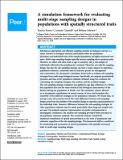Por favor, use este identificador para citar o enlazar a este item:
http://hdl.handle.net/10261/318661COMPARTIR / EXPORTAR:
 SHARE SHARE
 CORE
BASE CORE
BASE
|
|
| Visualizar otros formatos: MARC | Dublin Core | RDF | ORE | MODS | METS | DIDL | DATACITE | |

| Título: | A simulation framework for sub-sampling strategy evaluation in multi-stage sampling designs that accounts for spatially structured traits |
Autor: | Puerta, Patricia CSIC ORCID; Johnson, Bethany; Ciannelli, Lorenzo | Palabras clave: | Centro Oceanográfico de Baleares Medio Marino y Protección Ambiental |
Fecha de publicación: | 2019 | Editor: | PeerJ | Resumen: | Selecting an appropriate and efficient sampling strategy in biological surveys is a major concern in ecological research, particularly when the population abundance and individual traits of the sampled population are highly structured over space. Multi-stage sampling designs typically present sampling sites as primary units. However, to collect trait data, such as age or maturity, only a sub-sample of individuals collected in the sampling site is retained. Therefore, not only the sampling design, but also the sub-sampling strategy can have a major impact on important population estimates, commonly used as reference points for management and conservation. We developed a simulation framework to evaluate sub-sampling strategies from multi-stage biological surveys. Specifically, we compare quantitatively precision and bias of the population estimates obtained using two common but contrasting sub-sampling strategies: the random and the stratified designs. The sub-sampling strategy evaluation was applied to age data collection of a virtual fish population that has the same statistical and biological characteristics of the Eastern Bering Sea population of Pacific cod. The simulation scheme allowed us to incorporate contributions of several sources of error and to analyze the sensitivity of the different strategies in the population estimates. We found that, on average across all scenarios tested, the main differences between sub-sampling designs arise from the inability of the stratified design to reproduce spatial patterns of the individual traits. However, differences between the sub-sampling strategies in other population estimates may be small, particularly when large sub-sample sizes are used. On isolated scenarios (representative of specific environmental or demographic conditions), the random sub-sampling provided better precision in all population estimates analyzed. The sensitivity analysis revealed the important contribution of spatial autocorrelation in the error of population trait estimates, regardless of the sub-sampling design. This framework will be a useful tool for monitoring and assessment of natural populations with spatially structured traits in multi-stage sampling designs. | URI: | http://hdl.handle.net/10261/318661 | DOI: | 10.7717/peerj.6471 | ISSN: | 2167-8359 |
| Aparece en las colecciones: | (IEO) Artículos |
Ficheros en este ítem:
| Fichero | Descripción | Tamaño | Formato | |
|---|---|---|---|---|
| peerj-6471.pdf | 14,23 MB | Adobe PDF |  Visualizar/Abrir |
CORE Recommender
PubMed Central
Citations
2
checked on 15-abr-2024
SCOPUSTM
Citations
4
checked on 18-may-2024
WEB OF SCIENCETM
Citations
4
checked on 27-feb-2024
Page view(s)
27
checked on 20-may-2024
Download(s)
4
checked on 20-may-2024

